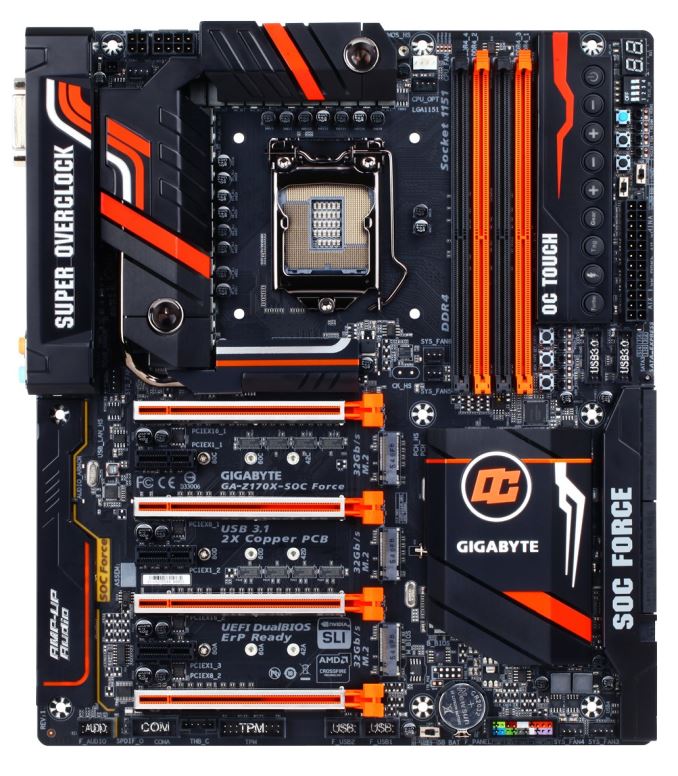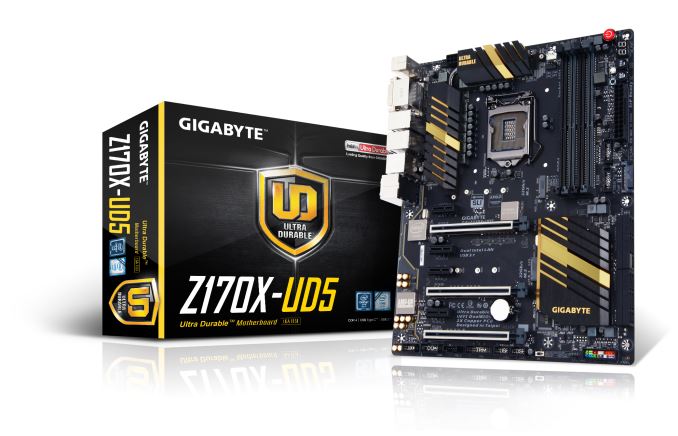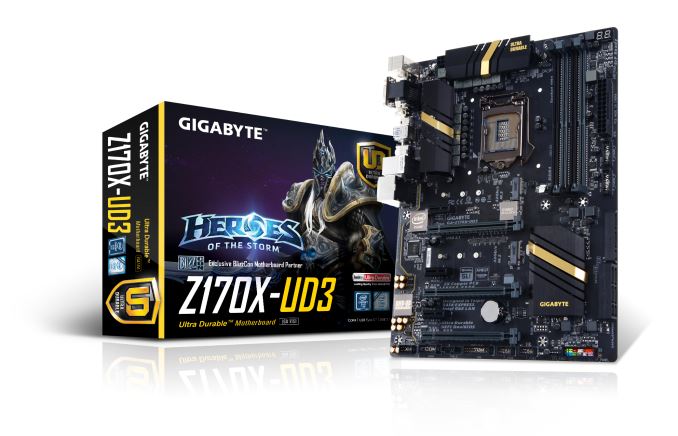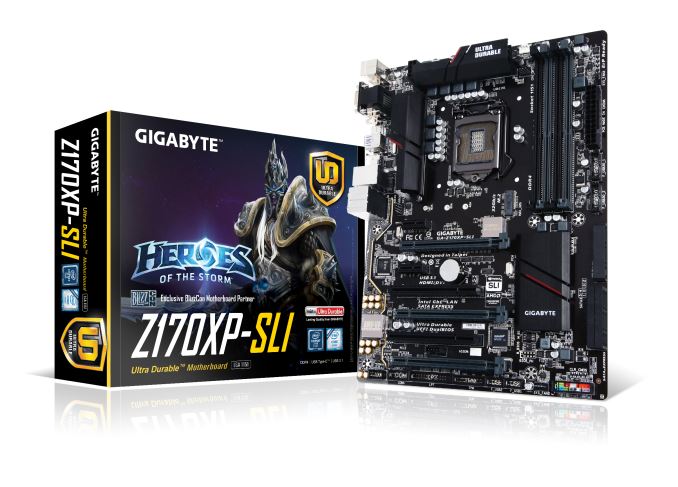Intel Skylake Z170 Motherboards: A Quick Look at 55+ New Products
by Ian Cutress on August 5, 2015 7:59 AM ESTGIGABYTE Z170: Super-Overclock and Ultra Durable
GIGABYTE Z170X-SOC Force
We’ve tracked GIGABYTE’s overclocking motherboards over the years, and interviewed motherboard product manager Jackson Hsu at the height of the Z87X-SOC launch when they were selling SOC motherboards quicker than they could be made. GIGABYTE tends to make anywhere from one to three overclocking models, including an ‘everything’ board and a ‘stripped’ version for extreme overclockers. At this point, the ‘everything’ board is the one being focused on.
We don’t have much information about the SOC Force at this time, but it is clear that the Force and the G1 are both aiming for the high end of their markets respectively. Similar to the G1 the power delivery heatsink is an air/water combination that stretches around the board. The SOC Force also has a 16+4+2 phase power arrangement, and under that second heatsink is also a PLX chip to allow for four-way SLI with x8/x8/x8/x8. The PCIe slots are also shielded to prevent damage, and between the slots are four separate M.2 PCIe 3.0 x4 slots.
The SOC Force as a whole moves into the E-ATX form factor, expanding to the right due to the OC Panel next to the DRAM slots. In an update to the design, rather than the previous array of buttons on the PCB they now have a cover with a large number of options beside it still. These options are for the extreme overclocking crowd, and no doubt GIGABYTE will be trying to challenge for records for the longevity of the platform.
The expanded PCB helps other features to fit on, such as the 8 SATA ports with the tri-SATA Express arrangement similar to the Gaming motherboards. For USB 3.1, the SOC Force has a Type-C and a Type-A on the rear panel, though at this time it is unclear if we are using the ASMedia ASM1142 or the Intel Alpine Ridge controller. The network controller is the Intel I219-V, escaping the clutches of the Killer line.
GIGABYTE has previously loved to play in the cheap overclocking space for mainstream platforms, and although we don’t have any information on a sub-$200 product coming, I would be surprised if one was not in the works.
GIGABYTE Z170X-UD5 - MSRP $190
GIGABYTE’s regular home-build motherboards form the Ultra Durable line, coming with a designation from UD3 to UD9. At this point in time only the UD3 and UD5 have been announced, and both look more like run-of-the-mill motherboards compared to their gaming counterparts. The styling is less garish with fewer custom LEDs or loud colors. That being said, both of them have similar hardware arrangements to the gaming line with the gaming parts replaced.
As a result, the UD5 here has a double Intel network solution, an enhanced Realtek ALC1150 audio orientation and standard three-way graphics support via x8/x4/x4. The PCIe shields are here by virtue of their use in actually supporting the PCIe slot rather than a gaming function. GIGABYTE is still using the Alpine Ridge controller for the USB 3.1 ports, here giving a USB 3.1-C and a single USB 3.1-A. There is no HDMI 2.0 on the UD5.
Storage comes via eight SATA ports, three SATA Express ports and the two M.2 slots in the middle of the board that run at full PCIe 3.0 x4 bandwidth. Given the UD5’s positioning, we might see it being bundled with an M.2 to U.2 converter – or if a UD7 comes out later, it might be added there.
GIGABYTE Z170X-UD3 - MSRP $165
The UD3 removes the PCIe metal shielding and dials down the heatsink styling again to a more reserved black and slightly gold look. We move down to a single network port, two fewer SATA ports and replace the DisplayPort with a VGA connector, but keep dual M.2 slots, the Alpine Ridge based USB 3.1 A+C combination and an x8/x4/x4 PCIe arrangement. The audio is also still GIGABYTE’s upgraded Realtek ALC1150 solution.
GIGABYTE Z170XP-SLI - MSRP $150
There also tends to be a model at the bottom of the Ultra Durable stack specifically for SLI. While not called ‘UD’ by name, the Z170XP-SLI carries the branding:
The Z170XP-SLI is the UD3 with even less styling on the power delivery, namely because the power delivery is dialed back for fewer phases. One of the internal PCIe 3.0 x1 slots also changes to a PCI slot by way of a bridge chip. This also seems to be the point where GIGABYTE changes to the ASMedia ASM1142 controller for USB 3.1 ports, and providing the A+C combination as before.
GIGABYTE Z170-D3H ($115) / Z170-HD3 ($115) / Z170-HD3P ($125)
The rest of the channel line we have information on focuses on the ‘3’ part of the product line, and as such aims for base functionality of the chipset with a few added extras with each name suggesting a different added feature that the others do not have. In this case, the D3H has an upgraded audio and Intel network controller while the other two have Realtek, and the HD3 is the one without USB 3.1 from the ASMedia controller. All three of these boards have a single PCIe 3.0 x16 and typically an x1 or x4 from the chipset, meaning that SLI will not work on them.

























_thumb.jpg)






_thumb.jpg)








85 Comments
View All Comments
mrlithium - Friday, August 7, 2015 - link
I was interested until i read " 2 SATA3" <- not gonna cut it buddy.Diagrafeas - Friday, October 9, 2015 - link
Addition...2 SATA Express (shared with 2 m.2 which are shared with 2 PCIE x16(x4 electrical)) and obviously 4 more SATA Ports.
So you could use 2x 1m.2/or 1PCIEx4/or 1SATA Express/or 2 SATA at time.
Etern205 - Wednesday, August 5, 2015 - link
Anyone notice some of those boards have extra pins on their socket.Eidigean - Wednesday, August 5, 2015 - link
The most appealing of all of these is actually the ASUS Z170-WS. No SATA-Express, 8x8x8x8 PCIe, 2 M.2 slots in RAID, a dedicated U.2 slot for a larger external drive, dual NICs, (hopefully) an Alpine Ridge USB 3.1 solution, and no Molex connector for PCIe power; instead a 3x2 12v header.Gigaplex - Wednesday, August 5, 2015 - link
I don't think the Asus has Alpine Ridge. The article mentioned Gigabyte has an exclusive right now.mrlithium - Friday, August 7, 2015 - link
i watched a review on Asus's youtube channel PCDIY where JJ said that I think the Z170-Deluxe would support thunderbolt with the addon card, which the board has to be designed for, so they must have decided that making people buy the add-on card would be a better optionN_rman - Friday, August 7, 2015 - link
Definitely the most appealing, i agree. The only one that's even close is the Asrock 7+, with 3 32gb/s M.2 ports.Deders - Wednesday, August 5, 2015 - link
Any news as to weather Kaby Lake will be supported on these sockets? Trying to decide whether to go all out on a mobo that will last me a long time or get something midrange and upgrade again next year.http://www.legitreviews.com/wp-content/uploads/201...
This slide seems to indicate that it will be but has there been any other confirmation?
Ian Cutress - Thursday, August 6, 2015 - link
That source isn't exactly trustworthy. Don't believe everything you see on the internet, some just post/repost it without verification in 'the interests of discussion'!As for the Kaby Lane compatibility, we haven't had confirmation but it would follow Intel's strategy.
Uxi - Wednesday, August 5, 2015 - link
The details about the 2nd M.2 slot being SATA only on the MSI M7 is incorrect, if I read the manual correctly. 2 PCIe 3.0 x4 SSD's can be used together with 4 SATA drives.